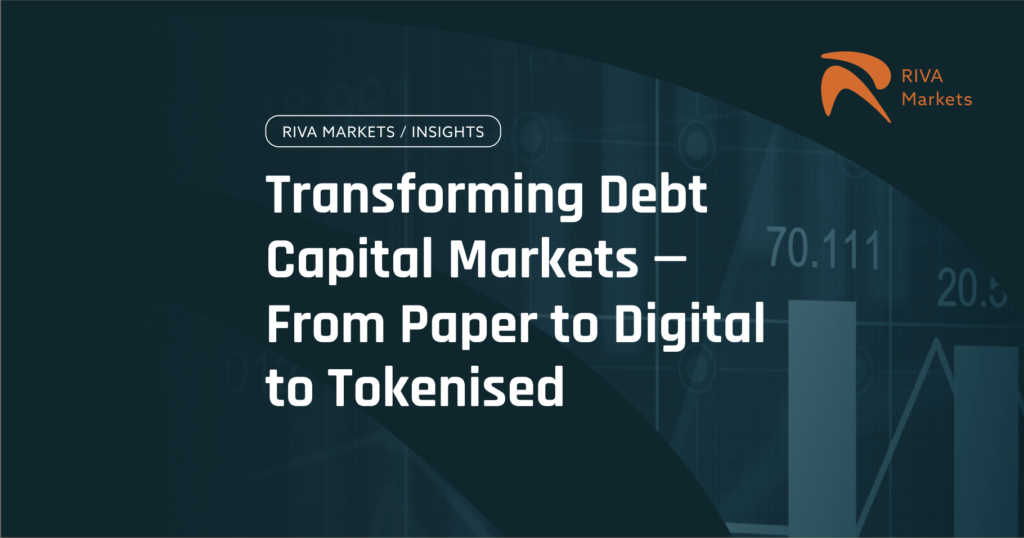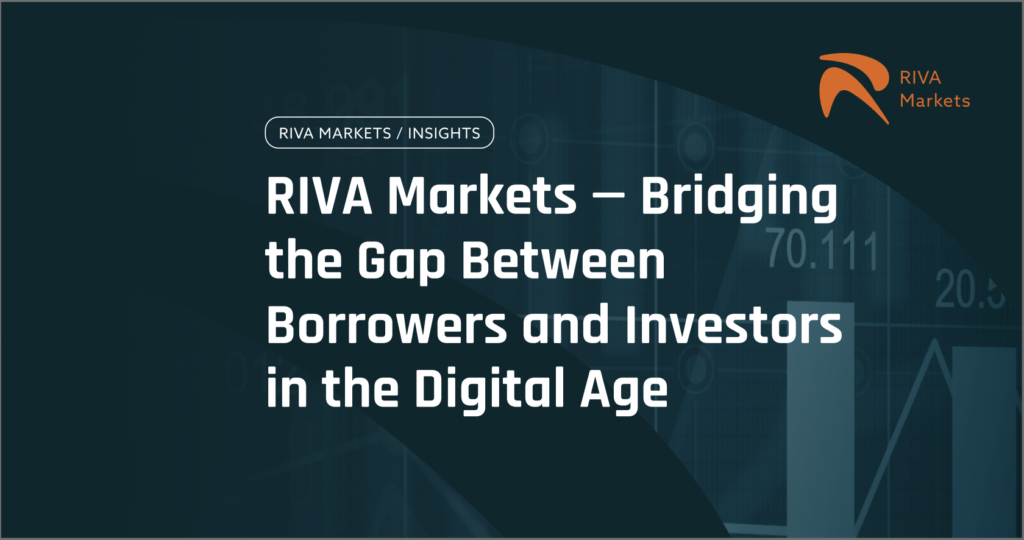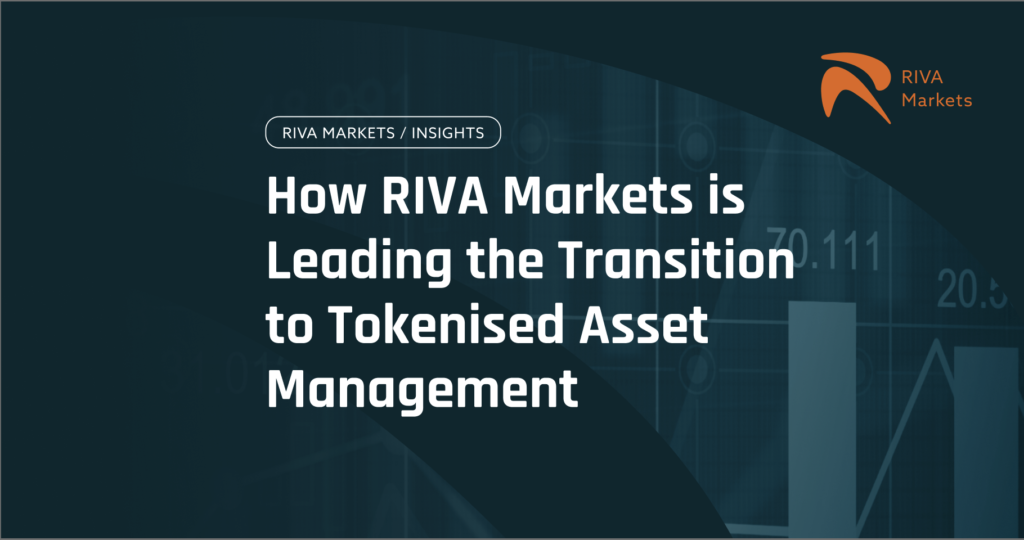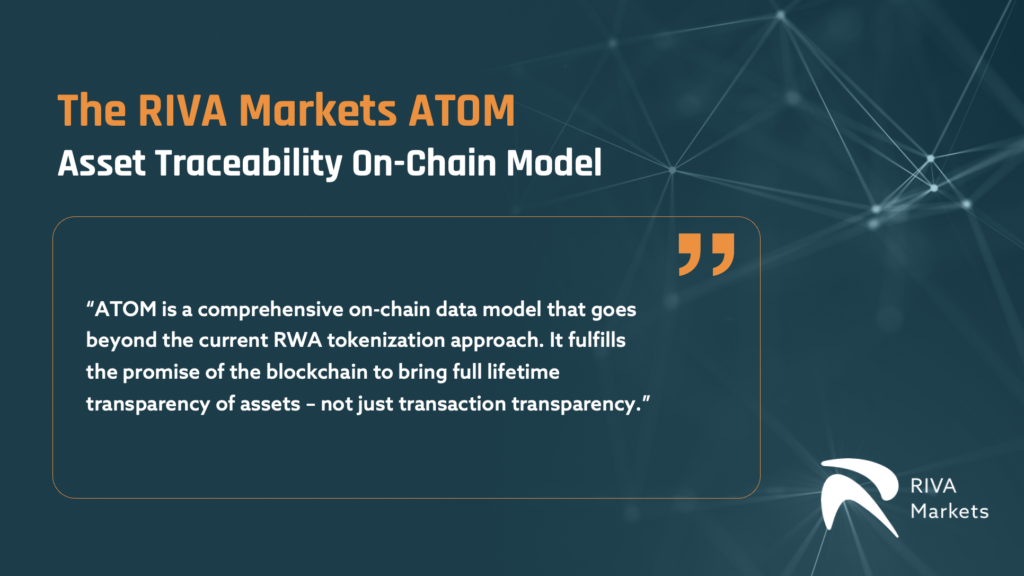
At RIVA Markets, we believe that the future of real-world asset (RWA) tokenization isn’t just about transferring assets onto the blockchain – it’s about issuing assets natively on-chain and bringing the asset’s entire lifecycle, data, and real-time insights on-chain.
We’re thrilled to reveal RIVA Markets’ ATOM — Asset Traceability On-Chain Model. ATOM is a comprehensive on-chain data model designed to bring the entire asset and lifecycle data for assets natively onto the blockchain, going far beyond the typical abstract models used for RWA tokenization. By doing so, RIVA enables unparalleled transparency and traceability for issuers, investors, asset managers, service providers and stakeholders, supporting a comprehensive approach for the future of asset management and secondary market trading.
In this article we want to dive into ATOM’s unique features, the benefits of leveraging the ERC-3643 standard for ATOM, RIVA’s interoperability strategy across EVM-compatible chains using Chainlink’s CCIP (Cross-Chain-Interoperability Protocol), and how ATOM integrates seamlessly with RIVA’s suite of services to reshape the tokenization landscape.
A Shift from Abstraction to Complete Asset Lifecycle Transparency
In most RWA tokenization solutions on the market, data is abstracted, providing only high-level information on underlying assets. This approach works for simple asset models but falls short on leveraging the true potentials and benefits of the blockchain and tokenized assets. With ATOM, RIVA Markets has taken a different route by bringing complete, detailed data for each asset natively onto the blockchain.
Instead of tokenizing an existing asset type with an abstract token model without the whole asset and lifecycle data stream, ATOM’s data model concept is based on a process-oriented lifecycle approach.
Asset Origination
By originating an asset like a loan directly on-chain, ATOM creates an on-chain ledger with an asset-specific data model. The asset-specific data model contains the full data structure of the asset, the entity model and the the financial model. Payment streams are defined such as payouts, repayment and interest payments for loans or coupon payments for bonds to create an asset balance that will be tracked and kept up-to-date in real-time.
Primary Issuance and Distribution
When an asset is initially originated it will be distributed through various ways like a prior agreed settlement and distribution to one or more investors, by listing on RIVA Markets and investment by matching investors or through investors subscriptions like for funds. ATOM contains on-chain subscription with regulatory and compliance rules as well multiple settlement methods like wire transfers, depository accounts or on-chain settlement that are recorded on-chain.
Asset Servicing
During a lifecycle, assets need to be serviced. This is especially the case for loans as it requires payouts, collection of interests and principal repayments, payment deferrals and dunning, terms changes, early repayments or distribution of payments to investors. ATOM’s smart contracts executes those servicing processes, updates the ledger and the balances and records all transactions and updates. Required service providers can directly integrate on the ledger layer for complete real-time accuracy.
Investor Servicing
Like assets, investors need to be serviced in terms of on-boarding, settlement and post-trade processes, reporting, payouts, redemptions or asset sales. Investor and asset ledgers needs to be synced, which is the main role of ATOM during the asset lifecycle.
Secondary Market Trading
A main benefit of securities, and even more for tokenized assets, is their tradability on secondary markets. ATOM is particularly valuable in secondary markets, where buyers and sellers benefit from immediate access to data-driven insights, real-time valuations, and the entire asset lifecycle. ATOM provides this transparency, executes the trades updates the records and balances.
As we’re directly integrating with Moody’s Analytics, this allows for real-time risk assessments and rating updates, empowering investors with essential insights at every stage of the investment lifecycle.
Built with Flexibility to Support Diverse Asset Classes
We started with commercial real estate finance such as residential, commercial, hotels and special projects, as we see the biggest potential and benefits in this highly antiquated but massive $13 trillion global market with a constant growth. Real estate debt is also probably the most complex loan type in terms of its data model and payment streams.
ATOM was developed with a flexible architecture, initially focusing on commercial real estate loans and a full on-chain fund model. The fund model was developed as the basis for RIVA Capital to structure and set-up funds natively on-chain. We therewith also want to demonstrate that funds can be set-up and managed fully on-chain and how such on-chain funds form a seamless and fully integrated ecosystem when investing in native on-chain and tokenized assets.
But ATOM’s flexibility doesn’t stop there. Designed to support a wide range of asset classes, ATOM can accommodate on-chain data structures for other asset types, like bonds, all kinds of private debt, equity to funds and REIT’s. This flexibility positions RIVA Markets as a powerful enabler for any institution looking to issue diverse asset types on the blockchain and benefit from full lifecycle traceability.
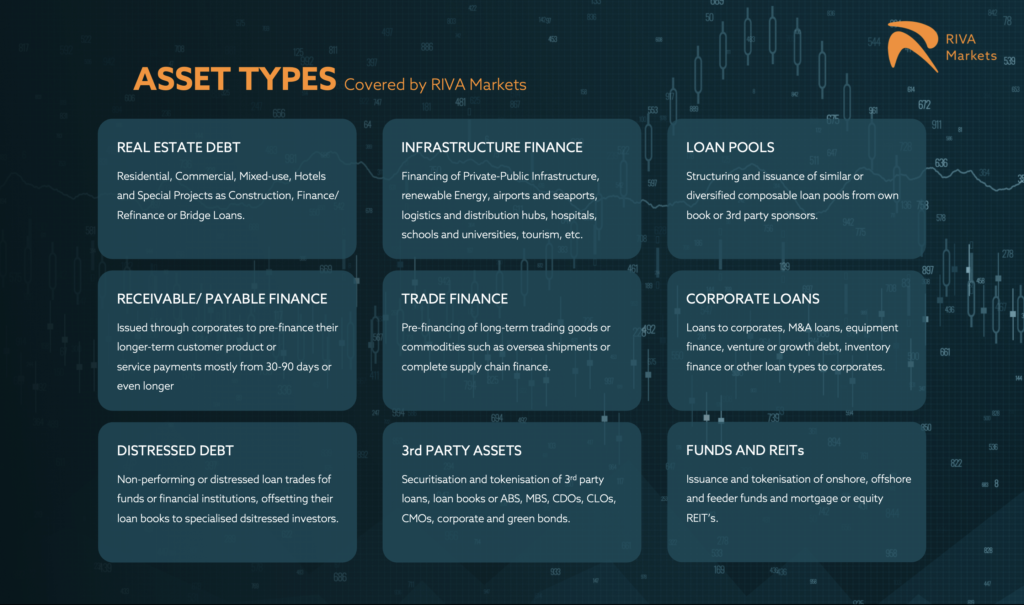
Powering the RIVA Suite: Modular Solutions for a Comprehensive Tokenization Ecosystem
ATOM is a central component of the RIVA ecosystem, which consists of four interconnected modules:
RIVA Prime: RIVA Prime is a comprehensive loan origination system to structure and issue loans natively on-chain. Prime is the starting point for ATOM, opening the on-chain ledger and determines the lifecycle management and servicing.
RIVA Securities: RIVA Securities transforms the assets to an actual investment product, either as on-chain security or as native tokenized asset for originated assets from Prime of 3rd party assets. It also allows to structure investment products such as ABS, MBS or CDO’s in a flexible composable way, as well as acts as the tokenization module for tokenized fund shares for the RIVA Capital fund module.
RIVA Markets: RIVA Markets takes the central role for investor access as primary issuance and for secondary market trading. ATOM’s lifecycle transparency ensures that every asset traded on RIVA Markets provides investors with deep insights and traceability, enhancing price discovery and liquidity.
RIVA Capital: RIVA Capital fully digitizes fund operation, allowing investors to set-up funds natively on-chain and construct diversified portfolios of tokenized assets. Using ATOM’s detailed data, investors can make well-informed decisions across various asset classes.
Together, these modules establish a fully integrated ecosystem, enabling both primary and secondary market activities with a focus on transparency, compliance, and interoperability.
Leveraging ERC-3643 (T-REX) for Compliant, Secure Tokenization
To support compliant and secure transactions, ATOM is built on the ERC-3643 (T-REX) standard. Developed by Tokeny, the T-REX protocol offers robust identity verification and compliance mechanisms, designed specifically for security tokens. Unlike typical ERC-20 tokens, ERC-3643 tokens include advanced compliance features and identity management, making them ideal for regulated environments.
The advantages of using ERC-3643 for RWA tokenization include:
- Identity Verification and Compliance: T-REX employs standards like ERC-734 and ERC-735 to manage on-chain identities and verifications. Trusted issuers validate identities and manage claim topics to control token transfers, ensuring that only verified participants can hold and trade tokens.
- Trusted Issuers Registry: A registry of trusted entities provides the basis for compliance, with checks occurring at the smart contract level to guarantee that only eligible participants engage with the tokens.
- Interoperability with ERC-20: While T-REX adds significant compliance features, it remains compatible with ERC-20 tokens, allowing for broader use within DeFi ecosystems.
These features ensure that assets tokenized using ATOM are secure, traceable, and fully compliant with industry standards — a critical feature for institutions and regulatory entities looking to engage in blockchain asset tokenization confidently.
A Hybrid Model for On-Chain and Non-Tokenized Assets
Recognizing that many investors are still not ready to transition to fully tokenized asset management, RIVA Markets offers a hybrid model that allows for both on-chain bilateral agreements and non-tokenized assets. This model provides a flexible entry point for investors who may not yet be ready to adopt tokenization while still benefiting from the transparency and efficiency of the on-chain ecosystem.
With RIVA’s hybrid approach, assets can be managed and utilized on-chain without immediate tokenization. However, investors retain the option to securitize and tokenize these assets at any time, further enhancing their potential for capital efficiency and market access. This flexibility supports a gradual transition to tokenized asset management, making it easier for traditional investors to enter the blockchain space.
By offering a full solution with a transition path to tokenization, RIVA Markets empowers investors to take control of their asset management strategies while benefiting from RIVA’s comprehensive suite of services.
Multi-Chain Interoperability: Connecting RWA Tokenization Across EVM Chains
The ATOM model is explicitly built for multi-chain interoperability, supporting issuance on different Layer 1 and Layer 2 chains. This flexibility allows assets to be issued on different chains, leveraging the strengths of each chain for various use cases.
To enable cross-chain functionality, ATOM integrates with Chainlink’s Cross-Chain Interoperability Protocol (CCIP), which provides secure and reliable asset transfers across blockchain networks. Chainlink CCIP ensures that tokenized assets retain their data integrity and security during cross-chain transactions, allowing for seamless trading across decentralized marketplaces.
This interoperability ensures that tokenized assets in the RIVA ecosystem are not limited by blockchain silos but can move freely across networks, enhancing liquidity, accessibility, and asset exposure.
The Future of Real-World Asset Tokenization with ATOM
ATOM, supported by RIVA’s comprehensive ecosystem and powered by the ERC-3643 standard, represents a major advancement in real-world asset tokenization. By bringing complete lifecycle data on-chain, ATOM provides investors with deep asset insights, supports secure and compliant transactions, and enables a liquid secondary market.
As RIVA continues to innovate, ATOM stands poised to become a foundational model for institutions looking to enter the blockchain space with a secure, transparent, and flexible solution. Through ATOM, RIVA Markets is not only enhancing the way assets are issued and managed on-chain, but redefining transparency, interoperability, and compliance for future blockchain-based asset markets.
Why ATOM Will Lead the Future of On-Chain Assets
At RIVA Markets, we’re committed to advancing on-chain assets by making them accessible, transparent, and liquid. With ATOM, we’re not just adding assets to the blockchain; we’re issuing them natively on-chain and provide true traceability and visibility that transforms how assets are managed, valued and traded. By creating an ecosystem where every stage of an asset’s lifecycle is available on-chain, we are equipping investors with tools that go beyond speculative trading to form robust, data-driven portfolios.
Key Benefits of the ATOM Model
Enhanced Trust and Investor Confidence: By capturing an asset’s full lifecycle and financial events, ATOM offers unprecedented transparency, helping investors understand what lies behind each token.
Data-Rich, Risk-Aware Investing: Integrated with Moody’s Analytics, ATOM provides ongoing risk insights, enabling smarter decision-making and agile portfolio adjustments.
On-Chain Credibility and Compliance: ATOM supports regulatory requirements and best practices, as every step in the asset lifecycle is visible on-chain, fostering a compliant ecosystem with reduced opacity.
Optimized for Secondary Markets: With ATOM, on-chain assets gain a new level of liquidity by making each asset’s history and risk profile accessible to prospective buyers in the secondary market.
ATOM and the Future of On-Chain Assets
The launch of the ATOM model is a major leap forward advancing tokenized real-world assets to native on-chain assets — making them transparent, accessible, and trusted investment vehicles. At RIVA Markets, we’re excited to lead this shift and invite our partners, investors, and the blockchain community to join us in redefining what tokenized assets can be.
The ATOM model doesn’t just symbolize a new model of tokenization — it’s a fundamental shift in how we think about real-world assets on the blockchain.
Welcome to the future of transparent, lifecycle-integrated on-chain asset management.

